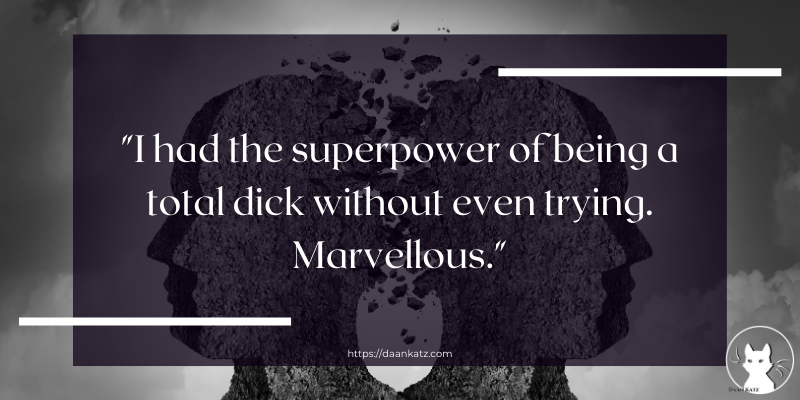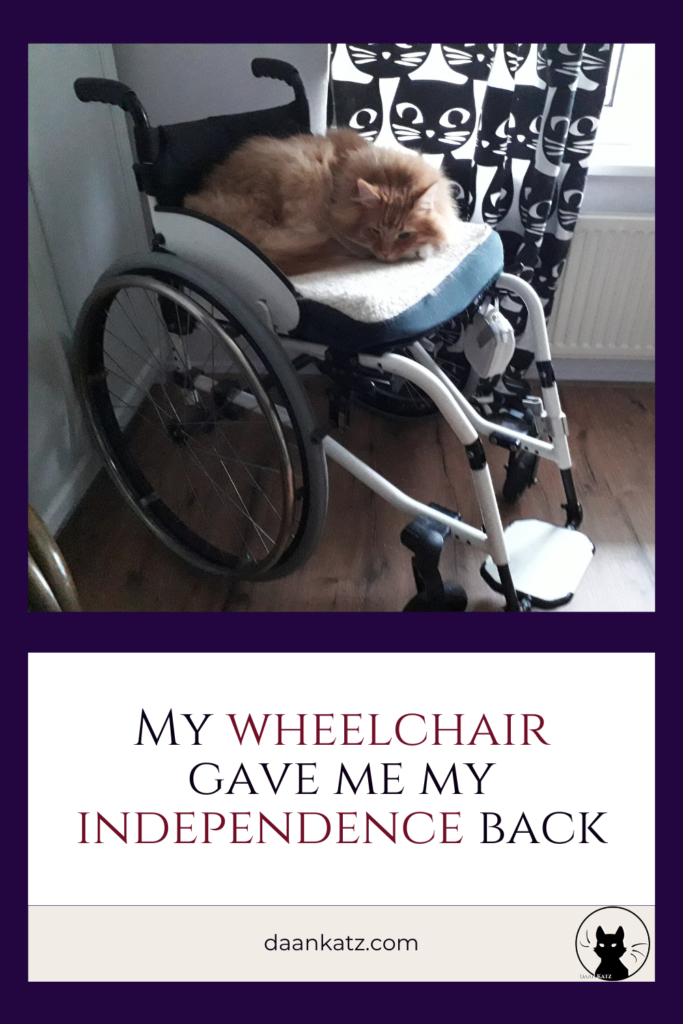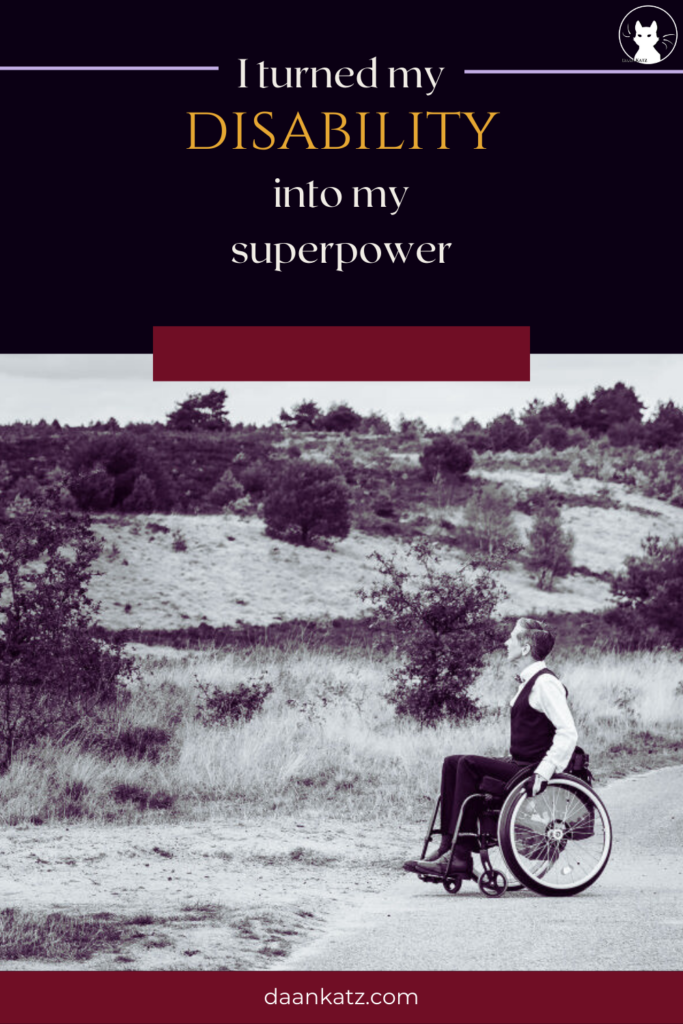Like many others, I was overwhelmed with a myriad of largely negative emotions when I became disabled—until I realised I could turn my disability into my superpower. Want to know how? Read on!
Table of Contents
Childhood Development
On the surface, my childhood development seemed quite normal. I learned to walk, talk, ride a bike, and all these other things children learn. Although, looking back, I realise I showed some very clear signs of my Ehlers-Danlos Syndrome, I didn’t know it at the time. Nor did my parents. Nobody suspected a thing.
Sure, there were some problems that prompted my mother to take me to the GP, who didn’t have an answer and referred me to a specialist, who couldn’t find anything wrong either. This pattern repeated several times, for several different medical issues, and nobody ever thought of EDS. Most of these specialists had probably never even heard of it. They certainly never took my hypermobility into account, the easy bruising, or my super soft and fragile skin.
So the doctors chalked my issues up to “nerves”—because that’s so much better than admitting that you just don’t know. And it could be true, right? Esp. for a child who doesn’t behave quite like other children their age and seems a bit “strange”.
Later on, my apparent “weirdness” got me some fancy diagnoses in the mental health department, as there, too, nobody saw what the real issue was: Autism. And if you think my having EDS as well as being autistic is an unlucky coincidence, think again. Research indicates a significant correlation between the Hypermobility Spectrum Disorders and the Autism Spectrum Disorders. Research also indicated both groups of disorders are highly under-diagnosed.
Invisible Disability
Yet, growing up, I never knew something was seriously wrong. I just needed to grow a thicker skin, and man up. Because that’s the message people had been sending me all these years: “You are a sissy.” And I had stupidly accepted their verdict and internalised it.
So I grew some balls. I walked more than I really should. Worked harder than was good for me. Got so tired I often woke up dizzy and so nauseous I would throw up if I even tried to sit up. The latter got, of course, chalked up to mental instability. All this in addition to being in constant pain.
My mental health, meanwhile, deteriorated. I was forced to engage with people when all I wanted was to curl up in a dark corner and shut the outside world out. The constant misunderstandings because people rarely say what they truly mean and are offended by honesty, frustrated me no end. Judging by how people treated me, I had the superpower to be a total dick without even trying. Marvellous.

Yet, all this time, I tried to fit in. To be like others, and not complain. I wanted to show them that I was no sissy and I could do everything any normal, healthy person could do. Because that’s what I was, right? A normal, healthy person.
Above all, I wanted people to genuinely like me for a change.
None of that happened.
Heel Spur, They Said… (Superpower: Ignoring Pain)
One day, as I was seeing my psychotherapist for my CPTSD (lifelong, constant bullying can easily do that to a person, you know?), she asked what happened to my leg. My leg? I was flabbergasted. Nothing happened to my leg. She then pointed out that I was limping. I hadn’t even noticed. That’s how well I had learned to ignore my pain.
I wasn’t alarmed. Not at first. It was probably just one of those things. Funny aches and pains that came out of nowhere happened all the time. It would resolve all by itself, I was sure.

“I thought it was just one of those weird things that happen sometimes. You know, those peculiar, inexplicable pains, aches and other funny sensations.” He tried to smile, but his face contorted into a painful grimace before the smile reached his eyes. I nodded. I knew it only too well. My life had basically been one long series of those puzzling events. Big black bruises for no apparent reason. Curious aches and pains that came and went. I never thought anything of it.
~ From my novel ”Death and the Maiden”

Only, this time, it didn’t. Over the months that followed, the limp grew worse. The pain got to the point where I could no longer ignore it, either. Every step hurt. Heel spur, the doctor said. It could take up to a year or two, but it would eventually clear up.
It didn’t. Instead, within less than a year, both feet were affected. The pain was always there. It got worse when I walked, and became tolerable when I sat or lay down, but it was never completely absent.
I applied for a mobility scooter, which should be provided to mobility impaired and elderly people under the Social Support Act, but my application was rejected because I was not old enough, and a heel spur diagnosis did not warrant the use of a mobility aid. In the end, we decided to rob a bank (our own bank accounts, I’m afraid…) so we could buy a mobility scooter. I felt like a fraud, but at least I could leave the house again.
Still, the doctors kept insisting it was heel spur. I knew, deep down, something else had to be wrong, but it took another few years of constant pain—and new pains in addition to the already existing aches and pains—before my GP decided to refer me to a rheumatologist.
Hypermobile Superpower
Hypermobility, the rheumy said, and gave me some useless advice that I had no idea how to implement. So I did some internet research, clicked some links, and found myself reading up on Ehlers-Danlos Syndrome. I could tick off so many boxes, I asked for (and got) a referral to a clinical geneticist who finally diagnosed me with hypermobile EDS.
I was angry and overcome with a profound feeling of loss. Angry at all these doctors who’d been so quick to dismiss my symptoms as psychogenic. How much damage to my body could have been prevented, or at least postponed, if they’d had enough sense to look for the proverbial zebra instead of the horse?
But it didn’t stop there, as now we were also dealing with concern for our children, who were diagnosed with hEDS shortly after me. Though we were by no means surprised, we were worried. What nasty surprises would the future hold for them?
Yet, I was also relieved. This proved that I was no sissy. I had a genetic disorder that caused my body to form defective connective tissue. I was no impostor for using my mobility scooter so I wouldn’t have to walk. My so-called heel-spur was something else entirely, and would never heal.
Miraculously, with my new diagnosis (of a condition I’ve had since birth), a lot of previously closed doors were now opened wide. I got a wheelchair. And a handbike. Braces. Custom made orthopaedic shoes. Therapies I didn’t even know existed. Understanding and cooperation instead of “it’s all in your head”. Household help.
Of course, I didn’t immediately embrace all these things. I dreaded having to use a wheelchair and put it off as long as possible—something I now regret. My wheelchair is the single best thing that happened to me since my EDS diagnosis.

My wheelchair gave me my independence back. Using my wheelchair full-time (well, almost full-time—I don’t sleep in it, and I do sometimes walk a few unsteady steps) has reduced my pain-levels enormously. So much so, in fact, that sometimes I walk too much inside the house. Which invariably causes the pain to return with a vengeance—a not-so-gentle reminder of why I need my wheelchair.
My Secret Superpower
I now use all these experiences and what I learnt from them—the good, the bad, and the ugly—in my writing. As a fantasy author, I craft stories with disabled heroes and heroines. Because I can! I have the power to show others that being disabled isn’t the utter disaster many people think. To show them we can, and do, live happy and meaningful lives.
Curious to find out how I use my superpower to bring the characters in my stories to life? Read my “Guide to Death and the Maiden”.

I’ll send it to you for free when you sign up for my newsletter.



